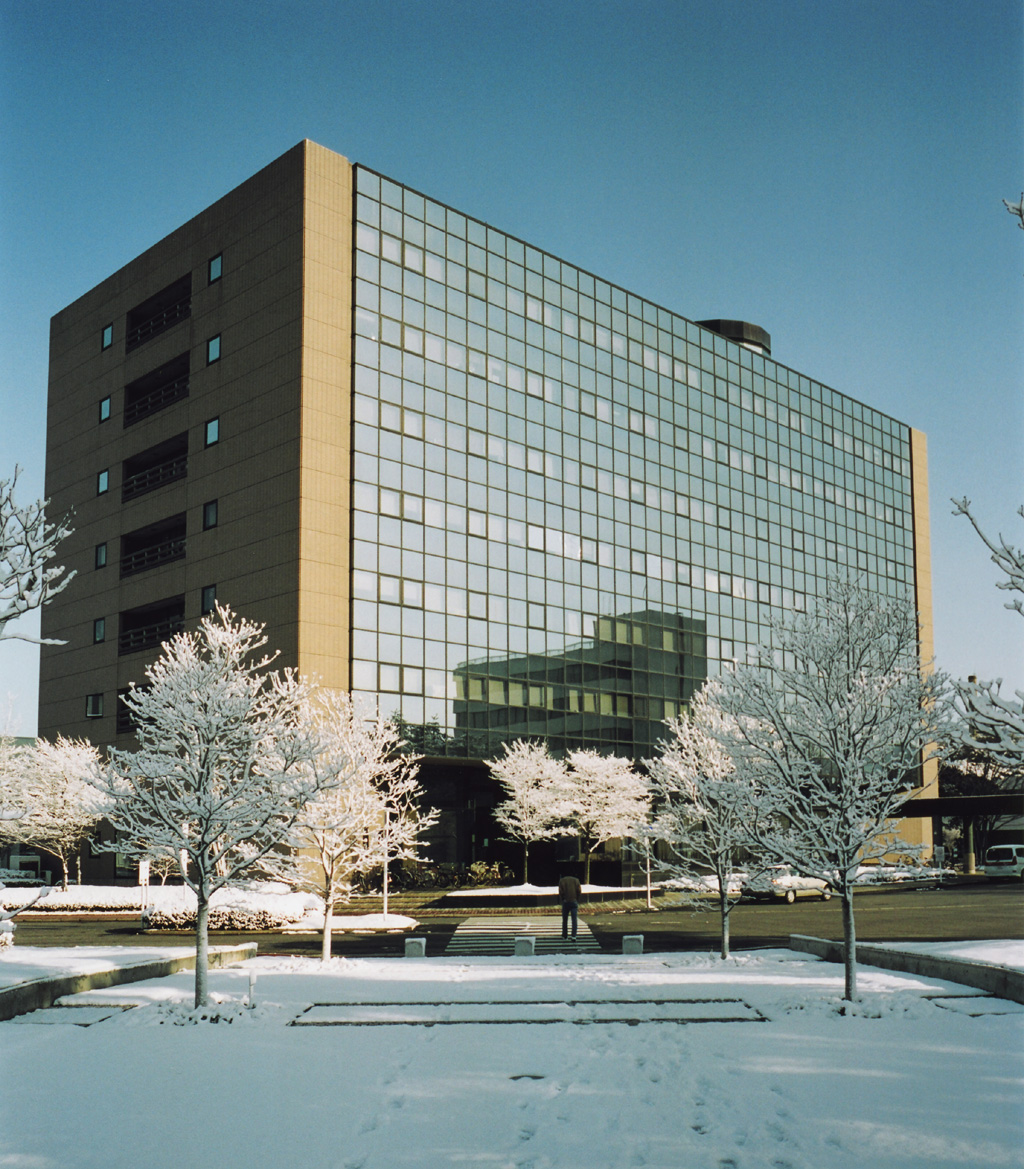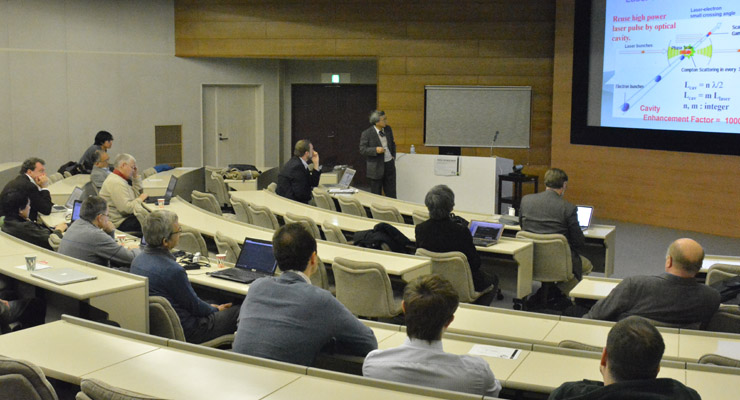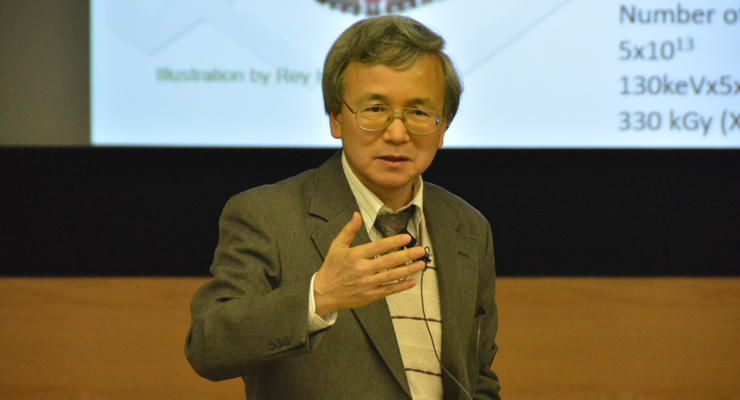Mini-Workshop
on Advanced Accelerator and Laser Technologies
for New Generation Light Sources

Photo: San-Go-Kan Bld., KEK
"Mini-Workshop on Advanced Accelerator and Laser Technologies for New Generation Light Sources" was completed successfully thanks to your contribution.
The purpose of mini-workshop was to discuss on the possibility of high brightness γ-ray generation.
We considered how to diagnose nuclear waste precisely using monochromatic γ-ray and how to generate high flux to determine amount of each species of nuclear waste quickly.
- Date: Friday, January 31, 2014
- Time: 09:00~18:00
- Venue: Seminar Hall, 1F, San-Go-Kan Bld., KEK, Tsukuba
KEK Campus Map: K03 - Location: High Energy Accelerator Research Organization, KEK
1-1 Oho, Tsukuba, Ibaraki, 305-0801, Japan - Access: How to reach KEK
- Registration:
- List of Participants
- Program
- Fee: Free
- Wireless LAN Service
- KEK Accommodation: KEK User Information
- Recommended Hotels (Please contact to them directly.)
- Urban Hotel (nearest KEK)
- Okura Frontier Hotel Tsukuba (near Tsukuba station)
- Daiwa Roynet Hotel Tsukuba (near Tsukuba station) - Link: NPNSNP
- Meeting Organizer: Junji URAKAWA, High Energy Accelerator Research Organization, KEK
List of Participants
- Cameron Geddes (Lawrence Berkeley National Laboratory)
- Eugene BULYAK (NSC KIPT, Kharkov, Ukraine)
- Petro GLADKYKH (NSC KIPT, Kharkov, Ukraine)
- Christopher Barty (Lawrence Livermore National Laboratory)
- Nedorezov Vladimir (INR RAS, Moscow)
- Ayano MAKINAGA (Hokkaido University)
- Dino Jaroszynski (University of Strathclyde)
- Massimo Ferrario (INFN LNF)
- Aurélien MARTENS (LAL, Orsay, France)
- Chary Rangacharyulu (University of Saskatchewan, Canada)
- Masami ANDO (Tokyo University of Science)
- Hideo TORAYA (Rigaku Corporation)
- Junji URAKAWA (KEK)
- Ryoichi HAJIMA (JAEA)
- Takehito HAYAKAWA (JAEA)
- Mamoru FUJIWARA (RCNP, Osaka University)
- Kazuyuki SAKAUE (Waseda University)
- Masafumi FUKUDA (KEK)
- Sakae ARAKI (KEK)
- Kentaro HARADA (KEK)
- Tsukasa MIYAJIMA (KEK)
- Akira UEDA (KEK)
- Takashi OBINA (KEK)
- Norio NAKAMURA (KEK)
- Miho SHIMADA (KEK)
- Ryota TAKAI (KEK)
- Hiroshi SAKAI (KEK)
- Kensei UMEMORI (KEK)
- Yosuke HONDA (KEK)
- Tomoya AKAGI (KEK)
- Hihoraka SHIMIZU (KEK)
- Alexander ARYSHEV (KEK)
- Konstantin LEKOMTSEV (KEK)
- Mikhail SHEVELEV (KEK)
- Ryuta TANAKA (Hiroshima University)

Photo: Seminar Hall, San-Go-Kan Bld., KEK

Photo: Junji URAKAWA, Meeting Organizer, KEK
Program
| Time | Topics | Speaker (Affiliation) |
|---|---|---|
| 09:00-09:20 | Registration & Coffee | |
| 09:20-10:00 | Consideration on future applications for high brightness γ-ray | Junji URAKAWA (KEK) |
| 10:00-10:40 | Advanced Acceleration Experiments at SPARC_LAB
XAbstractA new facility named SPARC_LAB (Sources for Plasma Accelerators and Radiation Compton with Lasers and Beams) has been recently launched at the INFN National Labs in Frascati, merging the potentialities of the an ultra-brilliant electron beam photoinjector and of a high power Ti:Sa laser. The test facility is now completed, hosting a 150 MeV high brightness electron beam injector which feeds a 12 meters long undulator. |
Massimo Ferrario (INFN LNF) |
| 10:40-11:20 | Laser and accelerator technologies for high brightness laser-Compton light sources
XAbstractAn overview of novel photo-gun laser, interaction laser and photo-gun technologies that enable efficient production of ultrahigh-brightness x-rays and gamma-rays via laser-Compton scattering will be presented. |
Christopher Barty (Lawrence Livermore National Laboratory) |
| 11:20-12:00 | Compact quasi-monoenergetic gamma ray sources based on Laser Plasma Accelerators
XAbstractNear-monoenergetic photon sources offer the promise of improved sensitivity at greatly reduced dose in existing applications and new capabilities in other applications, including active interrogation, treaty verification, NDA of spent nuclear fuel, and emergency response. While Thomson scattering is demonstrated to produce such high quality photon beams on large, conventional accelerators (e.g. the HIGS facility), compact machines are needed for field studies and operations. Compact sources can be enabled via laser-plasma accelerators (LPAs), which produce GeV electron beams in centimeters using the plasma wave driven by the radiation pressure of an intense laser. Operation principles of LPAs and photon source applications will be reviewed. Recent experiments will be discussed which improve the beam quality and efficiency of these accelerators towards application requirements. The path from current experiments to application relevant sources, and the associated laser challenges will be discussed. |
Cameron G.R. Geddes (Lawrence Berkeley National Laboratory) |
| 12:00-13:40 | Lunch Break | |
| 13:40-14:20 | Compton X-ray Imaging Advantages
XAbstractDistinctiveness of the Compton radiation, such as steep high energy cutoff of the spectrum and strong dependence of the cutoff on the electron energy, which in turn may be easily varied, opens prospects for application of the radiation in X-ray imaging. Another prosperous feature of the Compton radiation is connected with small -- tens of micrometers -- size of the emitting surface due to small waist of the laser focus. |
Eugene BULYAK (NSC KIPT, Kharkov, Ukraine) |
| 14:20-15:00 | The MightyLaser experiment: setup, results, perspectives | Aurélien Martens (LAL, Orsay, France) |
| 15:00-15:40 | Coffee Break | |
| 15:40-16:20 | Radiation sources based on laser-plasma wakefield accelerators | Dino Jaroszynski (University of Strathclyde) |
| 16:20-17:00 | Laser Compton scattering photon beams and other X-ray and gamma-ray sources
XAbstractA review on the Laser Compton scattering technique and obtained results is presented. A comparison of selected parameters of the gamma and X-ray beams obtained by different ways is discussed. |
Nedorezov Vladimir (INR RAS, Moscow, Russia) |
| 17:00-18:00 | Discussion | |